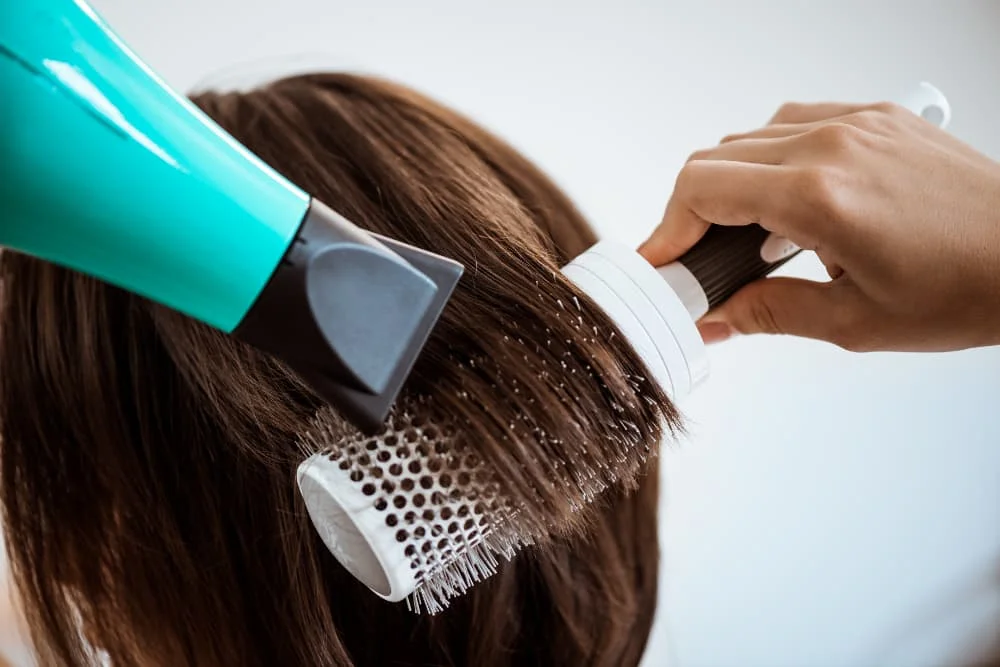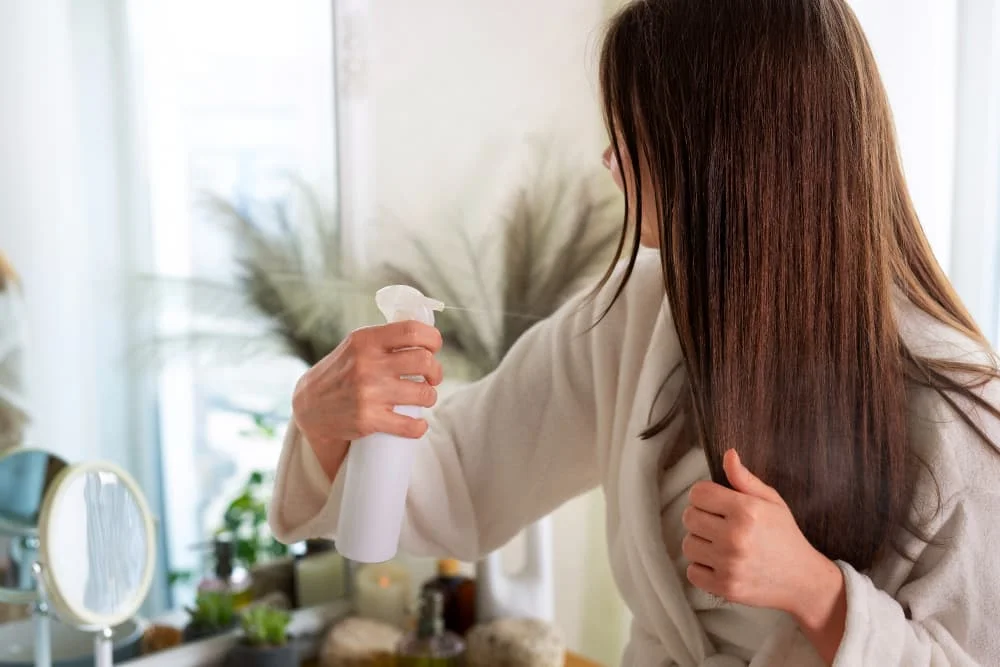Sleek, straight hair has a timeless appeal, and achieving that polished look is a goal for many. Whether you’re battling unruly curls, taming frizz or simply seeking a change, there’s a method out there for you to straight the hair effectively. This comprehensive guide will walk you through the world of hair straightening, exploring various techniques, essential tips, and product recommendations to help you achieve the straight hair of your dreams while keeping your locks healthy and damage-free. From heat styling to heatless methods, we’ll cover it all!
Understanding Your Hair Type
Before you reach for that flat iron, take a moment to understand your hair type. This knowledge will help you choose the most effective and least damaging straightening methods and products for your unique needs.
Hair types vary widely, from pin-straight strands to tight coils. Here’s a basic breakdown:
- Straight Hair: Straight hair has no discernible curl or wave pattern. It tends to be naturally smooth and shiny, but can sometimes be prone to oiliness.
- Wavy Hair: If your hair has a soft, “S” shaped wave, you fall into the wavy hair category. Has its own unique characteristics and styling needs.
- Curly Hair: Curly hair features defined loops or coils, ranging from loose waves to tight corkscrews. It often requires extra moisture as it tends to be drier and more prone to frizz compared to straight or wavy hair.
In addition to curl pattern, your hair’s thickness and texture also play a role in how it responds to straightening.
- Thickness: Strand thickness refers to the width of individual hair strands. Fine hair is typically slender and more susceptible to breakage, whereas coarse hair is denser and generally more durable.
- Texture: Describes the surface of the hair strands. Smooth hair has a closed cuticle, while rough hair has a raised cuticle, making it more prone to frizz.
These characteristics will guide you in selecting the most suitable straightening method. For example, fine hair might be more susceptible to heat damage, while coarse, curly hair might require higher heat or specialized treatments to achieve a straight look.
Why Does Hair Curl?
The secret to straight or curly hair lies within the tiny hair follicles hidden beneath your scalp. These follicles, along with the unique arrangement of proteins within each strand, determine your hair’s natural shape.
- Follicle Shape: Hair follicles are the tiny pockets in your skin from which hair grows. Oval or asymmetrical follicles produce curly hair, while round follicles produce straight hair.
- Protein Bonds: Keratin is a protein that makes up the hair shaft. In curly hair, the keratin proteins form more disulfide bonds, creating twists and turns in the hair structure.
So, if you’re looking to straighten those curls, you’ll essentially be temporarily breaking and reforming those protein bonds to create a smoother, straighter shape.
Heat Straightening Methods

Heat styling tools like flat irons and blow dryers are popular choices for achieving sleek, straight the hair. While they offer quick and effective results, it’s crucial to use them correctly to minimize the risk of heat damage.
- Pros: Effective for most hair types, provides quick results, can create polished and sleek looks.
- Cons: Can cause heat damage if not used properly, may not be suitable for damaged hair.
- Best for: Most hair types, especially those with moderate to coarse texture.
- Examples: Flat irons, blow drying with a round brush.
Let’s explore these methods.
1. How to Straighten Hair with a Flat Iron Safely and Effectively
A flat iron, also known as a straightening iron, uses heated plates to smooth and straighten the hair. Here’s a step-by-step guide to using flat iron effectively and safely:
- Start with dry hair: Before you fire up your flat iron, make absolutely sure your hair is completely dry. Applying heat to damp hair can cause serious damage, leading to sizzling, breakage, and even split ends.
- Apply a heat protectant: A heat protectant spray or serum is your hair’s best friend when it comes to heat styling. This protective layer minimizes damage by acting as a shield between your precious strands and the intense heat of the flat iron.
- Section your hair: To make the straightening process smoother and more manageable, divide your hair into smaller sections using clips. This will help you ensure that each strand receives adequate attention and heat is distributed evenly.
- Choose the right temperature: When it comes to choosing the right temperature for your flat iron, it’s best to start low and go slow. Fine hair is more delicate and requires lower temperatures, whereas thicker hair can tolerate higher heat levels.
- Clamp and glide: Take a small section of hair and clamp the flat iron close to the roots, leaving a small distance to avoid scalp burns. Gently glide the iron down the hair shaft, moving from root to tip in a smooth, continuous motion.
- Avoid repeated passes: Try to straighten each section with one or two passes to minimize heat exposure.
- Cool down: Allow your hair to cool completely before styling or touching it to set the straightness.
Tips for straightening hair with a flat iron:
- Use a good quality flat iron: Opt for a flat iron with ceramic or tourmaline plates, as these materials ensure even heat distribution, minimizing the risk.
- Don’t over-straighten: Avoid straightening your hair every day to minimize heat damage.
- Clean your flat iron regularly: Product buildup on the plates can affect the iron’s performance and potentially damage your hair.
2. Blow Drying Technique for Straight Hair

A blow dryer can also be used to straighten the hair, especially when combined with a round brush. Here are some tips for blow drying your hair straight:
- Pat your hair dry: Use a microfiber towel to gently squeeze out the excess moisture without rubbing, which helps minimize frizz and breakage.
- Apply a heat protectant: As with flat ironing, using a heat protectant is crucial when blow drying.
- Section your hair: Part your hair into smaller, manageable sections to simplify and speed up the styling process.
- Use a round brush: A round brush helps create tension and smooth the hair as you dry it.
- Direct the airflow downwards: Angle the blow dryer nozzle downwards to help smooth the hair cuticle and minimize frizz for a sleek finish.
- Move the dryer around: Avoid focusing heat on a single area for too long. Keep the dryer in motion to evenly distribute the heat and prevent damage to your hair.
- Finish with cool air: Once your hair is dry, use the cool setting on your blow dryer to add shine.
Tips for blow drying straight hair:
- Use a nozzle attachment: This helps concentrate the airflow and achieve a smoother finish.
- Choose the right brush size: Use a smaller brush for shorter hair and a larger brush for longer hair.
- Don’t over-dry your hair: Stop blow drying when your hair is almost dry to avoid over-drying and frizz.
3. Common Mistakes with Heat Straightening
When using heat styling tools, it’s easy to make mistakes that can damage your hair. Here are some common mistakes you should avoid:
- Turning down the heat is key to protecting your hair: Excessive heat from styling tools can damage the hair’s protective outer layer (the cuticle), leading to dryness, breakage, and frizz. Begin with the lowest heat setting on your styling tool and increase gradually if necessary, ensuring you only use as much heat as your hair needs.
- Not Protecting Hair Before Straightening: Applying a heat protectant spray or serum is crucial to minimize heat damage. These products create a barrier between your hair and the heat, helping to prevent dryness and breakage.
- Straight the Wet Hair: Never apply heat to wet hair. This can cause the water to boil and damage the hair shaft.
- Repeatedly Straightening the Same Section: Avoid going over the same section of hair multiple times with the flat iron, as this can cause excessive heat damage.
- Using a Dirty Flat Iron: Product buildup on the plates of your flat iron can transfer to your hair and cause damage. Clean your flat iron regularly.
By steering clear of these common errors and following the recommended tips, you can use heat styling tools to straighten your hair effectively while keeping it healthy and shiny.
Heatless Straightening Methods
If you’re looking for gentler ways to straighten the hair without relying on heat styling tools, there are several effective heatless methods you can try. These techniques minimize heat damage, promote hair health, and can even be done overnight for convenience.
Heatless Straightening:
- Pros: Gentle on hair, minimizes damage, can be done overnight for convenience.
- Cons: May not be as effective as heat straightening for very curly hair, results may not last as long.
- Best for: Fine or delicate hair, those looking to avoid heat damage, or for creating subtle effects.
- Examples: Banding, natural hair masks, overnight wrapping.
1. Overnight Straightening Technique: Wake Up with Smooth Strands

Overnight techniques offer a convenient and healthy way to straight the hair while you sleep. These methods utilize simple tools and techniques to gently guide your hair into a straighter shape as you rest. Let’s delve into two popular options that can help you wake up with beautifully straight hair.
Banding Method
This technique involves dividing your hair into sections and using soft, fabric hair ties to secure each part along its length.
- Start when your hair is damp.
- Separate your hair into multiple sections based on its thickness.
- Secure the top of each section with a fabric hair tie.
- Continue adding hair ties down the length of each section, spacing them a few inches apart, until you reach the ends.
- Leave the bands in overnight and remove them in the morning to reveal straighter hair.
Overnight Wrapping Technique
This technique involves wrapping damp hair around your head and securing it with bobby pins.
- Start with damp hair.
- Comb your hair to detangle it and part it in the middle.
- Take one section of hair and wrap it around your head, securing it with bobby pins.
- Wrap the next section in the opposite direction, following the same technique to create balance.
- Opt for a silk or satin pillowcase to reduce friction and minimize frizz while you sleep.
- Leave the wrap in overnight and remove the pins in the morning.
Tips for Overnight Straightening:
- Use a silk or satin pillowcase to minimize friction and frizz.
- Apply a leave-in conditioner or serum to damp hair before wrapping or banding.
- Ensure your hair is completely dry before removing the bands or pins in the morning.
2. The Twist Hair Bun Method

Looking for a heat-free way to achieve smoother, straighter hair? The twist hair bun method might be just the trick! This simple technique utilizes a twisted bun to gently stretch and straight the hair as you sleep, minimizing heat damage and maximizing convenience.
Here’s how it works:
- Begin with damp hair: Start with slightly damp, towel-dried hair.
- Create a high ponytail: Pull your hair up into a high ponytail positioned at the crown and secure it firmly with a hair band.
- Twist it up: Twist the ponytail tightly from the base to the ends.
- Form a bun: Wrap the twisted ponytail around itself to create a bun and secure it with another hair tie.
- Sleep tight: Leave the bun in place while you sleep.
- Unleash your straight hair: In the morning, gently unravel the bun and let your hair down. You’ll notice a smoother, straighter texture.
3. The Brush and Air Dry Method

For those with naturally straight or slightly wavy hair, the brush and air dry method can help enhance straightness and reduce frizz.
- Start by thoroughly cleansing and conditioning your hair.
- Afterward, gently blot your hair with a towel to remove excess moisture, avoiding any harsh rubbing.
- Apply a leave-in conditioner or a smoothing serum for added moisture and protection.
- Brush your hair every few minutes as it air dries, directing the brush downwards to encourage straightness.
This method is a gentle and effortless way to achieve a natural, straight look.
4. Wet Wrapping for Straight Hair

Wet wrapping is a technique that involves wrapping damp hair around the head and securing it with a scarf or cloth. This method can help stretch and straight the hair for curly or coily hair without heat.
- Wash your hair using a suitable shampoo, followed by a conditioner.
- Follow up with a leave-in conditioner or a styling cream for added moisture and manageability.
- Comb your hair to detangle it and part it in the middle.
- Take one section of hair and wrap it around your head, smoothing it as you go.
- Secure the section with bobby pins or clips.
- Turn the remaining section in the opposite direction to wrap it.
- Drape a silk or satin scarf over your hair.
- Leave the wrap in place for a few hours or keep it overnight for best results.
- Unwrap in the morning and style as you like.
Wet wrapping can be a bit time-consuming, but it’s a great option for those with curly hair who want to avoid heat damage.
5. Natural Hair Masks for Straightening
Certain natural ingredients can help smooth and straighten the hair. Here are a few DIY hair mask recipes you can try:
- Coconut Milk and Lemon Mask: Combine 1 cup of coconut milk with the juice of 1 lemon. Apply to hair, leave on for 30 minutes, then rinse.
- Honey and Olive Oil Mask: Combine 2 tablespoons of honey with 1 tablespoon of olive oil. Apply the mixture to your hair, let it sit for 30 minutes, then rinse thoroughly.
- Aloe Vera and Milk Mask: Blend 2 tablespoons of aloe vera gel with 1/4 cup of milk. Apply to hair, leave on for 30 minutes, then rinse.
These masks can help moisturize, nourish, and smooth hair, making it easier to straighten.
6. Straightening with a Cold Blow Dryer
Believe it or not, you can straighten your hair with a blow dryer without using heat! Simply use the cool setting on your blow dryer and a round brush to gently stretch and straighten your hair as you dry it. This method takes a bit longer, but it’s a great option for those with fine or delicate hair who want to avoid heat damage.
7. Proper Towel Drying for Straight Hair
The way you towel dry your hair can impact its straightness and frizz level. Instead of vigorously rubbing your hair with a towel, gently squeeze out excess water and then wrap your hair in a microfiber towel to absorb moisture. This helps minimize friction and frizz, making it easier to achieve a smooth, straight style.
Products for Straight Hair

Achieving and maintaining sleek, straight hair goes beyond just using the right techniques. Choosing the right hair care products is equally important. Here’s a guide to some essential items that can help you get and keep that smooth, straight the hair look you desire.
1. Heat Protectant Spray
Think of a heat protectant spray as a superhero for your hair. It swoops in to rescue your strands from the damaging effects of hot tools like flat irons and blow dryers. This essential product forms a protective shield around each hair shaft, preventing breakage and keeping your hair healthy and strong.
How to use: Simply spritz it onto damp hair before you start styling with heat.
2. Smoothing Serums
Want that sleek, glossy look? Smoothing serums are your secret weapon! These lightweight formulas work wonders to tame frizz, add shine, and make your hair incredibly soft and manageable. They work by coating the hair shaft, creating a smooth surface that reduces friction and enhances shine.
How to use: Take a small amount and work it through damp or dry hair, concentrating on the ends and areas prone to frizz.
3. Straightening Creams
For those who crave straight hair, straightening creams can be a game-changer. These creams are designed to loosen your hair’s natural curl pattern, making it much easier to straighten with or without heat. This means you can achieve your desired style with less effort and less heat damage.
How to use: Work a small amount of cream through damp hair from root to tip before blow drying or using a flat iron.
4. Leave-in Conditioners
Give your hair a dose of long-lasting hydration with a leave-in conditioner. These nourishing formulas are like a drink of water for thirsty strands, detangling, smoothing, and protecting your hair from daily wear and tear. They’re especially beneficial for those with dry or damaged hair.
How to use: After cleansing and conditioning, apply the leave-in conditioner to damp hair. Comb through to ensure it is evenly distributed.
Choosing the Right Products
- Fine Hair: Opt for lightweight formulas that won’t make your hair feel heavy.
- Thick Hair: Choose richer, deeply hydrating products to control frizz and add moisture.
- Curly Hair: Look for products specifically crafted for curls to enhance definition and manageability.
Remember to check the ingredients! Choose products with natural oils and vitamins and avoid harsh chemicals.
By choosing the right products for your hair type, you can achieve smoother, straighter hair without sacrificing its health.
Maintaining Straight Hair

You’ve put in the effort to straight the hair, now let’s make that sleek style last! Keeping your hair straight involves some effort, but with the right methods and products, you can maintain smooth, frizz-free locks for an extended period.
How to Prevent Frizz
Frizz is the enemy of straight hair. Those pesky flyaways and unruly strands can quickly ruin a sleek style. Here are some tips to keep frizz at bay:
- Hydrate, hydrate, hydrate: Dryness is a major culprit behind frizz. Use a hydrating shampoo and conditioner, and think about incorporating a leave-in conditioner or hair oil into your routine for added moisture and shine.
- Dry your hair gently: Be gentle when drying your hair—avoid vigorous rubbing, as it can damage the hair cuticle and lead to frizz. Instead, softly press and squeeze out the moisture, using a microfiber towel to absorb the excess water without causing disruption.
- Use a heat protectant: Spray a heat protectant onto your hair before using any hot styling tools. This forms a protective layer, minimizing heat damage and keeping frizz under control, ensuring your hair remains sleek and healthy.
- Choose the right brush: Use a boar bristle brush or a wide-tooth comb to detangle your hair, as these types of brushes are less likely to cause frizz.
- Sleep on a silk pillowcase: Silk fabric reduces friction compared to cotton, helping to minimize frizz and prevent tangles as you sleep, keeping your hair smoother and more manageable overnight.
- Consider anti-frizz products: Serums, creams, and sprays specifically designed to combat frizz can help tame unruly strands and keep your hair looking smooth.
How to Keep Straight Hair Overnight
Want to wake up with straight the hair? Follow these tips to preserve your style while you sleep:
- Wrap it up: Wrap your hair around your head and secure it with bobby pins or a silk scarf. This helps keep your hair smooth and prevents tangles.
- Braid it: Braiding your hair before bed can help prevent tangles and keep your hair relatively straight.
- Sleep on a silk or satin pillowcase: As mentioned earlier, these materials create less friction, reducing frizz and helping your hair stay straight.
- Use a hair net: A hair net can help keep your hair in place and prevent tangles while you sleep.
- Avoid sleeping with wet hair: Sleeping with wet hair can lead to frizz and tangles. Make sure your hair is completely dry before hitting the pillow.
- Apply a leave-in conditioner or serum: This can help keep your hair hydrated and smooth throughout the night.
Incorporate these tips into your hair care regimen to keep your hair sleek and straight for longer, ensuring a smooth and polished appearance every day.






